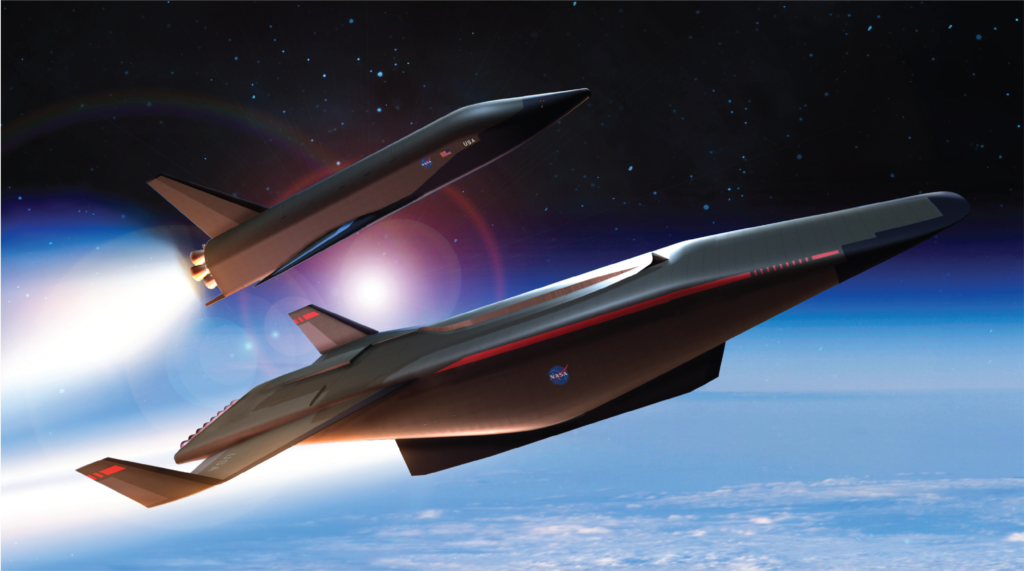Hypersonics

Activity Summary
Status: Active
In the field of aerodynamics, hypersonics is generally associated with flight through an atmosphere at speeds in excess of Mach 5, i.e. five times the local speed of sound. NASA, and its predecessor the National Advisory Committee for Aeronautics (NACA), have been involved in the study of hypersonic flight since the 1950s, with significant understanding of hypersonic flight phenomena being obtained from the highly successful X-15 program, and continuing with manned orbital flights of the Mercury, Gemini and Apollo programs, as well as the Space Shuttle.
In addition to rocket propelled craft travelling at hypersonic speeds, NASA has also studied hypersonic airbreathing propulsion (ramjets and scramjets) and related craft for decades. With successful tests of such propulsion devices in ground facilities in the 1960s, NASA planned to flight test the first of its kind experimental engine, called the Hypersonic Research Engine (HRE), aboard a modified X-15 vehicle. A test flight of a dummy (unpowered) HRE aboard the X-15A-2 ended with unexpected structural damage to the pylon holding the HRE, as a result of complex shock interaction and magnified aerodynamic heating. Continued flight testing of the HRE was postponed and ended with termination of the X-15 program. The HRE, however, would go on to be successfully tested in ground facilities at NASA Langley at speeds up to Mach 7. The first successful flight test of a scramjet would have to wait until February 1998 when a cooperative effort between NASA and the Russian Central Institute of Aviation Motors (CIAM) tested a hydrogen fueled axisymmetric scramjet flown atop a modified Russian SA-5 surface to air missile.

X-43A
Around the same time in the late 1990s, NASA began to build what would become the first free-flying vehicle ever to be propelled by a scramjet engine. As part of the Hyper-X Program, NASA built three 12-ft long test vehicles known as X-43A. While the first test flight in 2001 was terminated prematurely after control surface failure on the rocket booster, in 2004 the second and third vehicles would go on to set airbreathing speed records at Mach 7 and at Mach 10, respectively. The Vehicle Analysis Branch (VAB) was instrumental in the highly successful program, making critical contributions in configuration development, aerodynamics, propulsion design, structural analysis, mission design and integrated performance. VAB also provided substantial design support to the X-43B, X-43C and X-43D vehicles, though none of those made it to flight prior to the program being cancelled.


HIFiRE
Several years after the X-43A vehicles flew, engineers at NASA (including several from VAB) joined with the Air Force Research Laboratory (AFRL) and their partners from Australia’s Defence Science and Technology Organisation (DSTO) to begin work on another scramjet flight experiment as part of the Hypersonic International Flight Research Experimentation Program (HIFiRE) Program. This test, known as HIFiRE Flight #2, would test a dual-mode ramjet / scramjet on top of a sounding rocket in accelerating flight from Mach 6 to Mach 8. Critical here, and the first test of its kind, was to test the engine as combustion transitioned from subsonic (as a ramjet) to fully supersonic (as a scramjet) along the flight. As NASA held primary responsibility for the design, analysis and performance of the engine, engineers from VAB again played critical roles on the flight study. These included engine performance analysis, aerodynamic analyses, uncertainty quantification of inlet operability, and overall mission design. HIFiRE Flight #2 flew a unique, depressed trajectory enabled by software modifications suggested by VAB and was ultimately able to gather an impressive data set not achievable in ground test.

Credits: WSMR / John Hamilton

Credits: AFRL

VAB and Hypersonics Today
Today, VAB supports the Hypersonic Technology Project (HTP) in its endeavors to further research into hypersonic phenomena while sustaining our core competencies and helping the U.S. achieve the ultimate end goal of routine hypersonic flight. HTP continues to work closely with its partners in the Department of Defense (DoD) in order to leverage investments in flight activities that develop and validate advanced physics-based models, while the DoD leverages NASA expertise, analyses, testing capabilities and computational models. VAB leads the systems analysis research theme for HTP, one of four focused areas of fundamental research.
The goal of the systems analysis research theme is to advance system-level design and analysis capabilities, enabling definitive systems analysis with quantified uncertainty in order to guide research and deliver the benefit and impact of hypersonic technologies at the system level.

VAB designs and studies advanced vehicle concepts employing hypersonic airbreathing propulsion, with application to high speed, long range endo-atmospheric flight as well as for space access. VAB uses these concepts not only to explore the art of the possible, but also to help HTP guide its research portfolio by providing technology goals and associated system-level impacts. VAB personnel also lead the development of advanced system-level uncertainty quantification methodologies. With limited ability to ground test hypersonic airbreathing engines at the condition, scale, and durations expected in flight, formal system-level uncertainty quantification is a critical element to enabling operational hypersonic vehicles.
